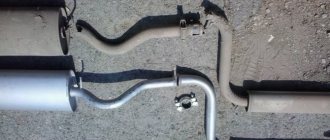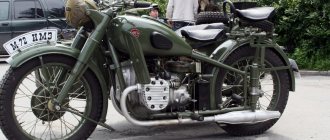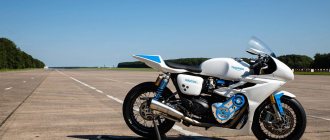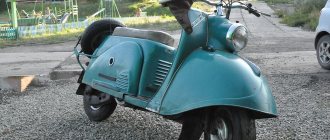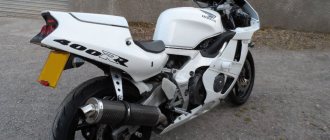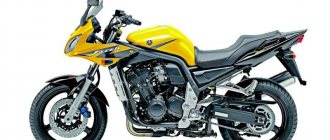The VAZ-2114 is a five-door hatchback produced by the Volzhsky Automobile Plant. The restyled version of the VAZ-2109 was produced under the code name “Samara-2”. The car differed from previous models in the unique design of the nose area of the body; it received new headlights, hood, radiator trim, bumpers and moldings.
The official presentation took place in 2001, and serial production of this vehicle continued for 10 years (from spring 2003 to December 2013). Throughout its history, the car has undergone various improvements. The Lada-2114 car was replaced by a new Lada Priora car.
The domestic hatchback VAZ-2114 is quite common among the young population and was often purchased for the first experience of driving a car. The vehicle belongs to the budget niche, so it is not worth demanding bright indicators and characteristics from the car. Lada-2114 is suitable for country trips, as it has good ground clearance, allowing it to cope with minor obstacles and uneven road surfaces.
CAR HISTORY
As mentioned above, the production of the “14th model” lay at the Volzhsky Automobile Plant. The car, which was equipped with a new name “Lada 2114 Samara-2”, was created on the platform of the famous VAZ-2109. Many owners of “nines” are already tired of the outdated front panel, so the new Europanel is very popular among drivers.
Serial production of the domestic hatchback began in 2003. The Lada-2114 Samara was equipped with the already familiar four-cylinder eight-valve 1.5-liter power plant, which was able to prove itself well in the 2109 model. When 2007 arrived, the car underwent an update that affected the technical part.
The line of power units has been replenished with a brand new 8-valve 1.6-liter engine. The catalyst was now installed directly next to the internal combustion engine, and it also received a plastic housing. The changes also affected the dashboard. The company pleased drivers with the presence of an on-board computer. The glove compartment in the upper part disappeared, and the panel itself was finished with hard plastic.
After 3 years, specialists significantly modernized the VAZ-2114 in 2010. Now under the hood of the domestic hatchback there was a sixteen-valve power unit from the Lada Priora.
Thanks to cooperation with the Recaro company, it was possible to equip the car with new seats and suspension. Production of the Lada VAZ-2114 was discontinued on December 24, 2013. The “transitional” version, represented by the 14th model, was successfully replaced by a new version from Lada - Priora.
APPEARANCE
Despite the release of a newer model, there are not many differences between the VAZ-2114 and VAZ-2109 in terms of bodywork. The new product had:
- New front part of the body;
- New lens shape;
- New hood;
- Another radiator grille;
- Improved quality of plastic on bumpers;
- Spoiler;
- Moldings;
- Door sill covers.
One thing can be said frankly: the VAZ-2114 was very lucky due to the policy pursued by the manufacturing company. In fact, the pioneer in this series was the VAZ-2115 sedan, which, as practice has shown, was a real pancake.
Taking into account the mistakes made, the innovations developed for the 15th and the use of time-tested features of the 2109, it was possible to release a complete and one of the most successful vehicles in the history of AvtoVAZ - the Lada-2114. The weight of the car was 970 kilograms, and its carrying capacity was 425 kilograms. Ground clearance height – 160 mm.
After improvements in 2011, the ground clearance was increased by 5 millimeters. This was achieved thanks to the installation of racks from Lada Priora. Between the headlights there is a small radiator grille. This decision was made partly due to the fact that the engine does not need a large air flow for cooling. It is in this place that the handle for opening the hood is located, which is very practical.
The VAZ-2114 car has become much better than its predecessor in terms of appearance and interior design. The design turned out to be more streamlined and stylish.
The side part of the VAZ-2114 has external mirrors made in a rectangular shape. Thanks to this solution, the driver has better control of the situation on the road. I would also like to mention the doors of the 14th model. They have a special opening mechanism, which makes boarding and disembarking passengers more comfortable.
According to statements by AvtoVAZ designers, the door opening angle is almost 90 percent. Not every car can boast such characteristics to improve the level of comfort for its passengers and owner. The five-door model comes with 13-inch wheels, which, if desired, can be replaced with more massive ones.
The rear part was completed with an eye to new ideas and solutions. The stern of the VA-2114 has modified headlights, which received 3 signals: stop, reverse and turn signals. This element is very practical and interesting. Moreover, this solution saves a little space. Almost all automobile concerns use similar technologies.
In general, the appearance of the VAZ-2114 has become more pleasant, modern and not so sharp compared to the VAZ-2109. A stylish body kit along the entire edge of the car added some zest to the appearance. It's nice that the bumpers are now painted to match the body color. The exterior of the new product was equipped with sporty features: the headlights narrowed, the shape of the hood changed, and the body became more streamlined.
The aerodynamic performance was initially identical to that of the 2115 model. However, later, the drag coefficient of the updated Lada-2114 was even lower - 0.45 versus 0.46 for the “standard” 2109. But the balance of lift forces changed seriously: the total lift force increased slightly, but it was now distributed evenly across the axes. Due to such improvements, the quality of driving at high speeds improves.
A small feature of the Lada 2114 car is the installed spoiler, which allows you to increase road grip, as well as the dynamic data of the car. It’s doubly nice that such an element comes already in the basic version from the factory.
Lowriders movement
The Low Rider movement originated 60 years ago in the USA. In Russia, it has only now become relevant for car enthusiasts, and is especially popular among young people. “Low Riding” is a lowering of the car’s suspension; the lower the car “lies”, the better.
"Lada 2114" was no exception in this style. After shortening the suspension spring, the car becomes more stable. The appearance of the car is not for everyone; many criticize the style of lowered cars.
Also newfangled was the installation of air suspension on the fourteenth family. The advantage of this suspension is that the ground clearance can be adjusted. The cost of air suspension reaches 100,000 rubles.
As a rule, only original and branded wheels are installed on the car, or even left on standard wheels. Thousands of drivers spend a lot of money on modifying the “fourteenth”. In the photo, the Lada 2114 is presented in a lowered version.
INTERIOR
As for the interior decoration of the VAZ-2114, it has inexpensive but high-quality materials. The hard plastic of the front panel creaks a lot when driving. From the point of view of our drivers, the interior can even be considered “luxury”, since it has an on-board computer, a seat heating function, two power windows and fog lights.
The on-board computer displays information about the remaining gasoline in the tank, the number of kilometers that can still be driven, average consumption and time. The steering wheel is comfortable and can be easily adjusted to suit you. It’s very nice that the steering wheel does not interfere with a full view of the instruments on the panel. The interior of the updated VAZ-2114 also has a heater with an updated structure. The doors are equipped with central locks.
Separately, it is worth mentioning the new Europanel. It has two liquid crystal displays. The left corner of the “instrument board” is occupied by a temperature sensor, which informs the driver about the current engine temperature in order to prevent overheating of the power unit. This sensor is designed in the form of a scale. Next comes the tachometer, which has a round design.
The central upper part has indicators in the form of arrows. Near the engine speed sensor there is a scale that displays the speed of the machine. The maximum value on the speedometer is 200 kilometers per hour. Finally, the upper right part shows the level of gasoline in the tank. Under this sensor there were indicators for turning on the side lights and high beams, as well as a message about a malfunction of the brake system.
Not without an overboard thermometer. The driver's seat is not the most comfortable. It simply cannot be adjusted. When landing, the notch puts pressure on the lower back, and most car owners are guilty of this. The central part has emergency signs, which during normal operation of the vehicle look like an ordinary dark stripe.
Due to the new panel structure, interior ventilation has increased. We managed to eliminate the problem of air supply to the deflectors on the sides. The upholstery of the chairs has a fabric structure, which over time becomes covered with very noticeable abrasions. Many elements of the interior decoration have a lot of play and creaking, which can be heard even with the slightest movement. But it’s nice that such a defect can be easily eliminated.
Also, the restyled Lada 2114 model is equipped with seat belt fasteners from the “ten”. The ceiling received a customizable interior lighting flashlight. Lada 2114 does not have a lot of free space for passengers. The rear-mounted sofa is uncomfortable and uncomfortable on long trips. Although the rear seats can be folded down, in their normal state they take up a lot of space.
It will not be so comfortable for a tall person to sit in the back. In principle, even an ordinary person with average height will feel uncomfortable. The rear windows are manual. A lot of owners of the fourteenth model struggle with extraneous noise in the cabin using sound and vibration insulation. However, due to such improvements, the weight of the vehicle increases significantly.
Some VAZ-2114 owners complain that the rear doors are jammed, making them difficult to open. Also, the loud and unpleasant sound of doors closing has not gone away. If the back row is folded and the shelf is removed, the usable space inside the Russian hatchback will become larger – 600 liters. In the normal position, the luggage compartment does not have a large volume - 330 liters.
It’s also unpleasant that the factory shelf, which we talked about a little higher, constantly rattles. This is why many people advise buying an acoustic shelf that will dampen such unpleasant sounds. In general, the update had a positive impact mainly on the interior, although there are some controversial issues. For example, the stove has become more powerful, but because of this the noise level has increased.
SPECIFICATIONS
POWER UNIT
Over the 10 years of serial production of the Lada 2114, several power units were placed under its hood. First, it is worth mentioning the 1.5-liter, 8-valve engine, which developed 78 horsepower and 116 Nm. This engine consumed about 7.3 liters for every 100 kilometers in combined mode.
This modification has an injection intake controlled via an electronic unit, replacing the obsolete carburetor intake. Not without a new camshaft with adjusted phases. After AvtoVAZ introduced an injector into the VAZ-2114 engine, a group of engineers increased the efficiency of the engine, adding power to it. On the other hand, it was also possible to reduce the “fuel appetite”.
In 2004, a modification of the power unit was released, with a displacement of 1.6 liters. The engine already produced 81 horsepower and 125 Nm. In combined mode, the engine consumed 7.6 liters per hundred kilometers. The eight-valve injection power plant has an increased volume thanks to the cylinder height increased by 2.3 millimeters, which provided a longer piston stroke.
Instead of the ignition module, they began to install a coil. The new version of the engine has become more powerful and environmentally friendly, but gasoline consumption has increased when compared with the first 1.5-liter engine. In addition, in the same year they released a 1.6-liter version of the engine with a 16-valve system.
Such an engine already produced 89 “horses” and 131 Nm of rotational force. Based on the passport data, for every 100 kilometers you need 7.5 liters of gasoline in combined mode. In 2007, this engine was subjected to serious modification. The working volume remained at the same level – 1.6 liters. But power increased to 98 horsepower and 145 Nm of torque.
It’s nice that the increased power did not negatively affect the “fuel appetite”. According to the passport data, the new product consumes 7.2 liters of gasoline per 100 kilometers. They worked hard on the previous VAZ-2114 engine for 3 years and made several changes.
Engine with a displacement of 1.6 liters.
The connecting rod and piston group was lightened by as much as 39 percent. The drive of the gas distribution mechanism was changed - now it was tensioned automatically. The valve wells have become smaller in size. The quality of cylinder honing has increased significantly.
TRANSMISSION
All power plants of the VAZ-2114 work together with a five-speed manual transmission, which has been improved. All torque potential is transmitted exclusively to the front wheels. Both the transmission and the suspension were developed only by Russian engineers.
CHASSIS
The car was built on the platform of the previous model - the time-tested "nine" (VAZ-2109), which was subjected to serious modernization. The front wheels operate with McPherson struts, and the rear wheels with trailing arms or coil springs. Driving the car does not cause the most pleasant sensations, since there is no power steering.
The steering wheel itself is made of a rack and pinion type. The braking system of the domestic hatchback received disc brakes at the front and drum brakes at the rear. If we take the average speed limit of 80 kilometers per hour, then the braking distance with passengers will be 40 m.
SAFETY
It’s not very pleasant to talk about the safety level of the Lada-2114. The car does not have airbags and the body metal is too thin, which is not capable of providing the proper level of protection in an emergency. The vehicle is severely deformed even with mild impacts, so it is advisable not to drive at high speeds.
EQUIPMENT AND PRICES
The equipment of the Lada-2114 will not be very rich. However, the car is practical, unusual and has a whole list of necessary functions. The car has:
- Climate control;
- Seat with plenty of settings;
- A steering wheel that can be adjusted both in terms of reach and vertical plane;
- Instrument panel with engine speed and speed sensors;
- On-board computer;
- Central console with an abundance of buttons;
- Anti-lock braking system;
- Front seat heating function.
It is no longer possible to purchase a new VAZ 2114 car, since the production of this model has been stopped. But on the used car market you can buy a pretty good option. The price may vary depending on the year of manufacture, equipment and general condition. On average, this is about 240,000 Russian rubles.
Interior tuning
The last type of tuning is interior modernization. Most enthusiasts install LED lighting, which looks very stylish. You can replace the seats with sports versions or more comfortable ones made from quality materials. Loading the machine with all kinds of equipment is another way to improve. An acoustic system, a GPS navigator, a sophisticated on-board computer - there’s a place for everything. You can complete the tuning by tinting the windows. The main thing is not to overdo it. The interior of the VAZ-211440 is quite conservative and boring, so tuning will only benefit the car.
Until what year was the VAZ 2114 produced?
VAZ 2114 is a favorite car produced by the Lada concern, which is part of the Samara-2 family. The history of the VAZ 2114 began when the public saw the first models in 2001, then 50 test copies were produced. Full-scale production of the VAZ 2114 started in April 2003, and the last production of the VAZ 2114 was recorded on December 23, 2013.
The fourteenth model replaced the well-known VAZ 2109, called the “nine”, it lasted on the assembly line for seventeen long years from 1987 to 2004, but until 2011 it was assembled in Ukraine from kit cars. Little has been preserved from it in the form of the restyled VAZ 2114.
Controllability
The car's handling is difficult to call ideal. Yes, it takes turns, confidently accelerates, but at the same time it has a noticeable play when turning the steering wheel, which is several times higher than the permissible values. The “fourteenth” has an independent spring suspension at the front, and a semi-independent spring at the rear.
Being a car passenger also has a hard time - due to the stiff suspension, all road irregularities are felt in the cabin. You won’t be able to drive the “fourteenth” off-road either – any “diagonal” will take the driver by surprise. This car is designed for city and highway travel.
Changes to the car compared to its predecessor
In the updated model, not only the external part of the car has radically changed, but the interior has also been significantly updated.
External differences from its predecessor:
- Bumper . The bumper became higher and was painted in body color, like foreign cars; before it, the 10, 11 and 12 models could boast of this.
- Headlights . The headlights became smaller and more rounded, and the optics themselves were quite modern at that time.
- Rear spoiler . Some trim levels were equipped from the factory with a small spoiler that did not differ in color from the car.
- Radiator trim and hood . The hood also differed favorably from its angular predecessor with its rounded shape, which made the 2114's design quite fresh.
- Wings . Slots for turn signals appeared in the wings and, in general, they began to integrate more advantageously into the overall appearance of the car.
- Side skirt fairings . The sills began to be covered with plastic covers and painted the same color as the body.
- Moldings . The moldings go along the doors and are in turn painted to match the color of the car's body.
All this made the VAZ 2114 quite attractive and modern, which, coupled with its low price, promised success for the model. The changes, by the way, did not affect the rear of the car, although initially the engineers planned to change the appearance of the rear lights. The idea was abandoned due to unreasonable increases in production costs.
Looking into the salon, you can find updated:
- Torpedo . The new torpedo was made according to European standards and lost the second glove compartment in the luxury configuration. The plastic has become less creaky than in the nine.
- Dashboard . Although not new, since the instrument panel was already installed on the VAZ 2110, it migrated here, unlike the old one, it had a more modern appearance.
- Steering wheel and steering column . The fourteenth model was equipped with a new, at that time, steering wheel from a VAZ 2110, and a knob for adjusting it appeared on the steering column.
- Seat belt fastenings have found their highest points.
Sitting in the restyled cabin has become much more pleasant and comfortable, and many additional pleasant goodies have appeared, such as:
- electric window lifters;
- heated seats;
- air conditioner;
- fog lights;
- central door locking;
- standard on-board computer;
- alloy wheels and tinting.
There were only two configurations available: basic and luxury. They did not differ much in both price and equipment. The luxury one had a plastic cover on the engine for decoration, a plastic receiver and a standard on-board computer.
In addition, the engineers took care of upgrading the clutch system, gearbox, suspension, braking system and technical equipment in general.
Throughout the history of production, the VAZ 2114 has been equipped with 4 types of engines:
- Having a volume of 1.5 liters, the power of which was 77 horsepower, from 2003 to 2007.
- From 2007 until the moment when the VAZ 2114 was no longer produced, two engine options of the same volume 1.6, with a power of 81 and 90 hp, were installed.
- In 2010, models with updated engines of the same displacement began to appear, but it already had a power of up to 98 hp.
Popular “six”: four million cars
The second most popular model in the history of AVTOVAZ is the “six” (VAZ-2106). Its serial production began in 1976 and continued until 2006. In total, more than 4 million “sixes” were produced.
The basis for the VAZ-2106 was the 1972 FIAT 124 Speciale. The “Six” had a relatively powerful engine with a volume of 1.6 liters and a power of 75 hp. With. and reached speeds of up to 152 km/h.
It was a four-door, five-seat model with a four- or five-speed transmission and a sedan body style. Modern details have appeared in the decoration of the new car: plastic edging of the headlights, radiator grille, license plate illumination. Sound insulation in the cabins has been improved, the front seats have been equipped with headrests, and the seats have been contoured.




